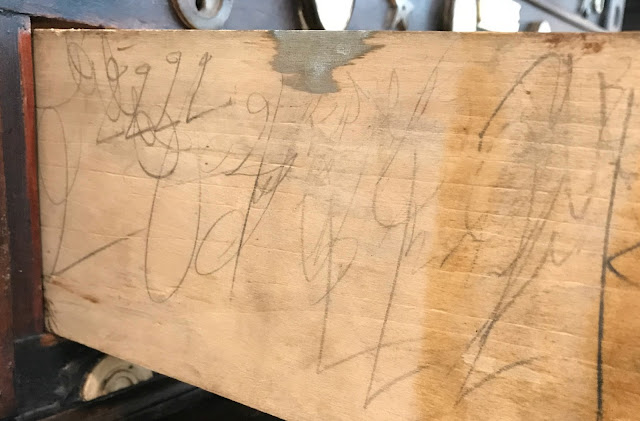 |
| The name and date of the bloodiest day in American history appear on the front of the secretary. (CLICK ON IMAGES TO ENLARGE.) |
 |
| Crafted to honor Private John Bingham, the secretary is on display at the Wadsworth Museum of Art. |
UPDATE: The secretary mentioned in this post was exposed in 2018 as a forgery.
 |
| Carving of Lincoln in cattle bone on the front of the secretary. |
A 17-year-old private in the 16th Connecticut, John Bingham had been killed in the 40-Acre Cornfield on Sept. 17, 1862. His 16-year-old brother, Wells, broke the awful news to his father. "It is a sad tale which I am about to tell you," the private in Company H of the 16th Connecticut wrote three days after the battle. "Poor, poor John is no more." (See interactive panorama of 40-Acre Cornfield on my photo blog.)
As he went to view John's body on the battlefield, Wells was so overcome by the gruesome death scenes in the vast, rolling field just outside the village of Sharpsburg, Md., that he couldn't bear to look at his brother. "I thought that if he looked like any of them which I saw there," the teenager wrote, "I did not want to see him."
 |
| Left: 16th Connecticut Private John Bingham, 17, was killed at Antietam. Right: His 16-year-old brother Wells survived. (Photos courtesy of Military and Historical Image Bank) |
 |
| A small plaque on the front of the secretary was made from a shard of John Bingham's knife. |
 |
| A typewritten note inside the front drawer of the secretary is signed by Wells Bingham's son, Edgar. |
 |
| A newspaper story about the 16th Connecticut's reunion at Antietam in 1889 appears under glass inside a secretary door. |
"Presented to Wells A. Bingham by his friends. The secretary a rememberance of his brother John F. Bingham who offered up his life at Antietam, Maryland Sept. 17, 1862. The encased star a remnant of the colors carried that day by the 16th Infantry. The memory plaque made from a shard of his knife."Old newspaper clippings about the 16th Connecticut flag and a regimental reunion at Antietam are mounted under glass inside doors on the front of the secretary, now on display at Hartford's Wadsworth Atheneum Museum of Art. An unsigned note from 1900 found in a drawer of the secretary references "battlefields' thunder and flame." And glued inside another drawer is this typewritten note signed in ink by Wells Bingham's son, Edgar:
"This desk made for my father Wells Anderson Bingham. A tribute to his brother John killed September 17, 1862 at the battle of Antietam. They both served in the Connecticut Volunteer Infantry Company H. Both enlisted August 17, 1862 at South Manchester. The cased part of the regiment's flag was givin [sic] in honor by my father's close friend and comrade Sergeant Edgar C. Wheeler. I am proud to carry his name. The knife handle was in the possession of my father and with great sadness taken from the body of his brother after the battle."
-- Edgar M. Bingham
Northhampton, Massachusetts
September 22, 1972
Age 93
 |
| Antiques dealer Harold Gordon (right) examines the 16th Connecticut flag in the Hall of Flags at the State Capitol Building in Hartford in 2013. |
 |
| A canister attached to the secretary may hold a piece of the 16th Connecticut regimental flag.. |
After the war, pieces of the 16th Connecticut regimental flags were gathered by Andersonville survivors, sewn together to form a shield and scroll and mounted in the middle of a new silk flag, which was created by Tiffany and Co. in New York. During a 2013 visit with me to the State Capitol Building in Hartford where that flag is displayed, Gordon aimed to match his piece of flag with the shield and scroll on the flag made after the war. His comparison was inconclusive, but it merits an expert investigation.
Like his brother, Wells Bingham met a sad end. Alone in his Bloomfield, N.J., house at 58 Monroe Place while his wife, two sons and a daughter were away, the 58-year-old businessman inhaled "illuminating gas," killing himself on Aug. 16, 1904. An employee from his wallpaper company discovered his body. Bingham had $238.70 in his pocket. A suicide note to his wife "said his business worries prevented his sleeping and advised his sons never to enter the same business."
 |
| John Bingham's name appears prominently on the front of secretary. |
 |
| An inkwell mounted on front. |
Who crafted this impressive piece of furniture?
Who were the 16th Connecticut veterans who gave the unique piece of American folk art to Wells Bingham? What was so special about Wells that he merited such a beautiful gift?
Who was Edgar Wheeler, namesake of Edgar Bingham, who gave the "cased part of the regiment's flag" to Wells? Where did he get the small piece of "flag"?
Did the horrors Wells Bingham witnessed at Antietam have anything to do with his suicide?
And, finally, how did this amazing work of art ever get out of the Bingham family's hands?
We'll keep you posted.
 |
| An unsigned note from July 1900 found in the desk drawer. |
 |
| A clock, crowned with an eagle and including the words "The Union Preserved" near the base, is mounted on top. |
 |
| Pencil scrawling, perhaps by a child, on a secretary drawer. |
 |
| The secretary on display at the Wadsworth Atheneum Museum of Art in Hartford. (CLICK ON IMAGES TO ENLARGE.) |
Have something to add (or correct) in this post? E-mail me here.
SOURCES:
-- Marquis de Lafayette GAR Post No. 140 Record Book, April 13, 1904.
-- New York Times, Aug. 17, 1904.
-- Private Wells Bingham's letter to his father, Sept. 20, 1862, Antietam National Battlefield Research Library.
No comments:
Post a Comment